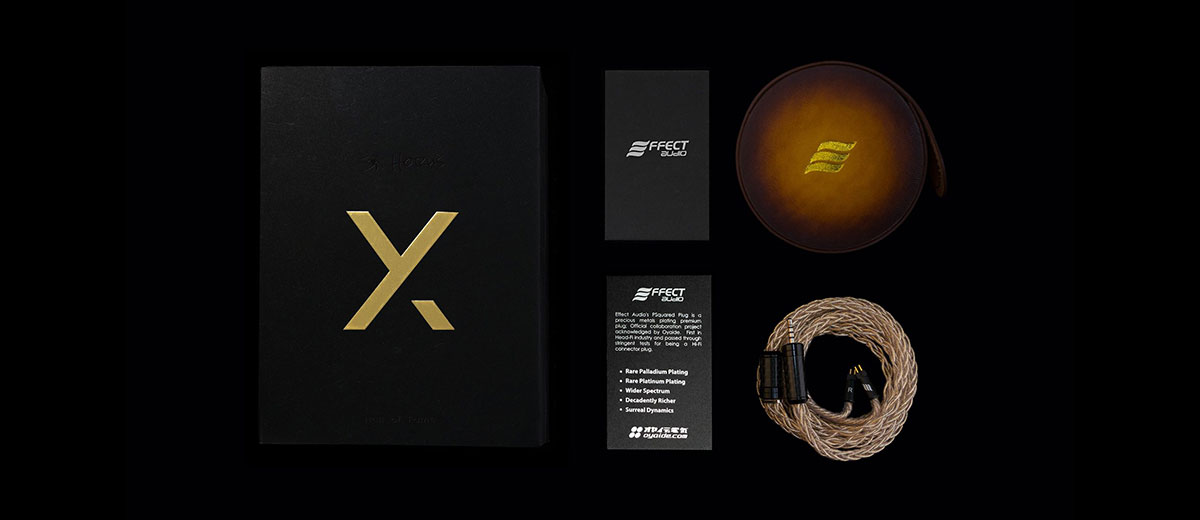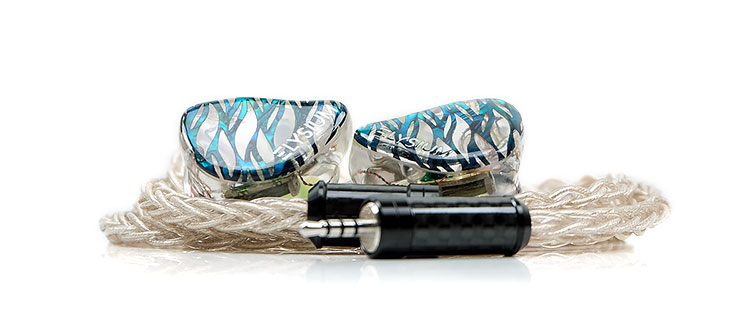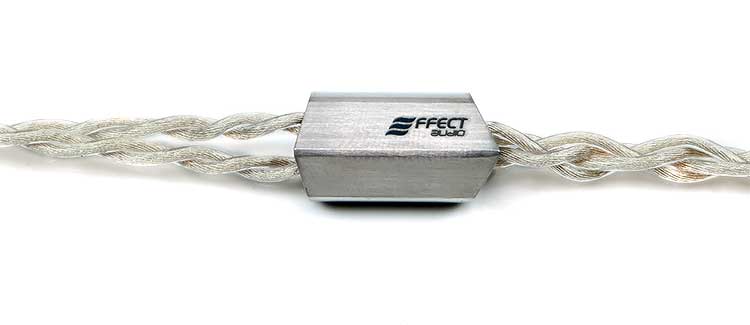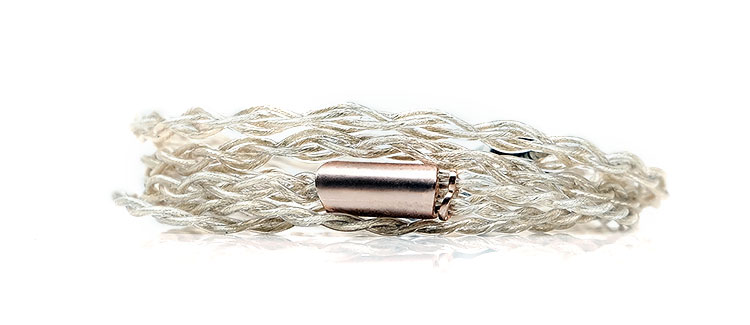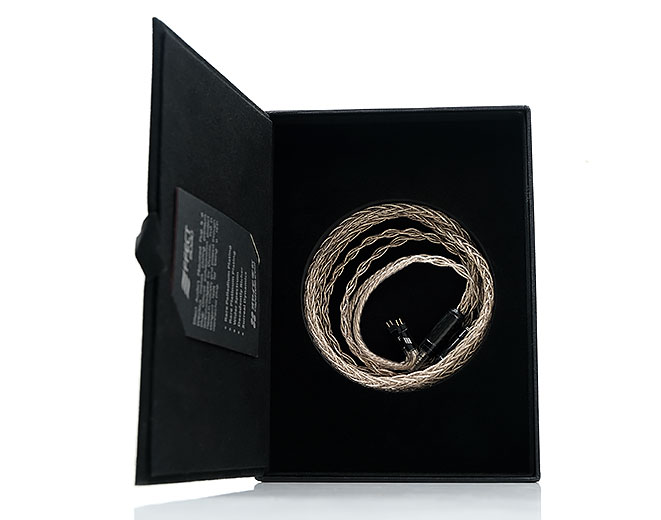Performance Impressions
(Our test samples include the FiiO M15, Cayin’s N6ii with the E01 motherboard, 64 Audio’s tia Trio, Empire Ears’ Zeus, and Vision Ears Elysium)
Summary
Now, having received the Horus for the first time and being able to approach both with a fresh perspective I would have to say that the Horus X is an upgrade but an extremely focused upgrade at that. It is also a unique or very different experience from Code 51’s more aggressive performance.
The X, when paired with our test monitors and source rig, delivers what I would loosely term as a “hi-fidelity’ experience but with a bit more girth or weight on the low-end than the more neutral Horus and an enhanced treble presence compared to Code 51.
However, it is not a bright sounding cable, rather, it allows monitors with a very particularly good treble performance to shine without any unnatural attenuation.
The low-end is not a hugely weighted explosive experience either. It is fuller sounding than the Horus for sure but it is delivered in a slightly politer manner than Code 51 with an emphasis on adding some additional warmth which I can pick up quite easily with our two-hybrid models that use the dynamic driver on the low-end, the tia Trio and the Solaris SE.
One surprising aspect of the Horus X performance was the difference in dynamic range and volume compared to the original 4-wire version. The gap was not huge and normally I expect a clear difference when jumping wire counts.
I do not think that is a negative critique of the Horus X, however. When compared to Effect Audio’s other 4-wire creations is a very dynamic experience and does very well indeed compared to other 8-wire creations from PLUSSOUND and Satin Audio.
Timbre
This is one area that has definitely changed going from the Horus to the Horus X. Everything now sounds a little “juicier’ and by that, I mean a little more weighted with richer notes and a harmonic balance that tilts more to the natural side. It does make the Horus sound the drier or more neutral of the two cables.
Most of that ‘juice’ is being driven by the enhanced low-end warmth the Horus X brings to the table. That, in turn, fattens out the lower-register instrumental notes so you get some great texture and detail within that texture. However, it is not a bloated smeary languid stroll, it is every bit as tight as the original Horus presentation with excellent layering on our DD hybrids.
I actually think this is also a great pairing with those clean or ethereal monitors such as the Empire Ear’s Zeus. It does not diminish those clean highs that the Zeus brings to the table but instead injects a little warmth into the midrange timbre and in turn, fleshes out the vocals without sucking out the air that the Zeus is known for.
Staging
With the Horus X is the depth is enhanced over the original with that additional weight adding a little more PRaT and power but not to the level of Code 51. This is closer to the Leonidas II Octa but not as relaxed sounding due to the enhanced treble presence. The X does extend further and sounds airier than the Octa’s top-end performance.
We used the new M15 from FiiO heavily in this comparison because of its slight bias to the mids and treble and I did find the Horus X doing better at allowing that treble presence to shine without sounding abrasive. Switching to the DX220/AMP1 MKII brought similar rewards in terms of staging height. These are two DAPs that seem to benefit from the Horus X’s airy but smooth treble performance.
One thing to note from the original Horus. The mids on our test monitors did not sound quite as aggressive and forward when used with the X. The Horus vocals seem close and intimate but my feeling is that it is due more to the very neutral low-end and clean highs.
The Horus X does not necessarily attenuate vocal presence but rather balances it out better with more low-end weight and slightly smoother delivery. I am not quite as laser-focused on vocals to the detriment of other imaging cues on the as I am with the Horus.
Synergy
This ultimately depends on what you want to achieve with your setup. If you are coming from the Horus original 4-wire it is going to be more about producing a slightly smoother richer tone without any loss of the original’s excellent articulation and treble presence. For those thinking about switching from the Leonidas II Octa, this is about increasing the treble presence and tightening up the midrange timbre.
I actually really enjoyed pairing the Horus X with clean and expansive sounding monitors like the Zeus as it amplifies that excellent treble response but at the same time and adds a touch of smoothness from a warmer and weightier low-end. It still sounds airy with the X but now not so brittle or glassy sounding.
One interesting pairing was the VE Elysium. The Elysium dynamic driver is configured for the mids so with the Horus I got a wall of vocals and a tamer low-end. It makes for an exquisite vocal performer but less of a ‘complete’ experience.
The Horus X takes the attention away from purely the vocals by injecting a bit more ‘oomph’ and body in that low-end BA driver. The X/Elysium pairing sounding the more holographic for me, the more balanced overall. If you want that upfront vocal performance then stick with the 4-wire Horus but if you want a bit more depth and complexity then the Horus X is better.
Select Comparisons
(As ever, to keep things consistent we select one source and one monitor. In this case, we used the FiiO M15 and the 64 Audio tia Trio.)
Effect Audio Code 51
$2388
I still feel Code 51 is the flagship rather than the Horus X despite being $100 cheaper. Not because of any technical superiority but rather the Horus X is a double the wire count of the previous Horus whereas Code 51 is something entirely new.
Technical
Code 51 is a larger 24AWG hybrid wire consisting of 3 distinct elements, gold-plated silver, silver-golds alloy, and palladium-plated silver. The Horus X is a smaller 26AWG wire using a single high-strand count of gold-plated silver.
However, Horus X is an 8-wire creation whereas Code 51 is 4-wire. The intention here is that the 24AWG large wire will perform pretty close to the 26AWG 8-wire.
Code 51 also uses a multi-strand Litz geometry and Golden Ratio principle in its wiring whereas the Horus X uses multi-sized stranding but no Litz or Golden Ratio principle. Neither are the strands in the Horus X individually enameled.
Design
The see two cables look quite different due to the finishing and the wire size. The 8-wire Horus X is bigger or thicker due to the additional wire wrap whereas Code 51 is about 60% of the thickness. Despite having half the wire count, Code 51 is not half the girth due to that larger 24AWG wire inside.
Both use EA UltraFlexi TM insulation which is soft and fairly transparent. Code 51 has a slightly duller yellow overtone whereas the Horus X has a lot more sparkle in its aesthetic. I do love 8-wire builds in how they can really show off a design due to the larger size.
Code 51 finishing is excellent and for my money a level above the Horus X with its Titanium splitter barrel and cinch. They look fresh, discreet, and exceptionally light with a chin cinch that simply works.
The black splitter barrel of the Horus X is a nice twist on their original design but the chin cinch needs to go back to the drawing board for articulation. Both have the same PSquared plug and connector options.
Handling
Handling on both is excellent however physics is what it is and the Horus X is the heavier of the two due to the additional wire. Code 51 is a little lighter and easier to manage as well as comfier around the ear. The cinch is also easier to operate on Code 51 though when both are adjusted they old their position just fine. Microphonics is not an issue on either cable.
Performance
Code 51 creates what I could loosely call “a bigger sound” with the tia Trio/M15 pairing. For me, that means a more planted low-end, fleshed out mids and a sweet fuller-sounding treble.
The presentation, whilst not being intimate, sounds more immediate, more dynamic, and in your face. It brings out a more aggressive response from the tia Trio dynamic driver which in turn adds more lower-order harmonic distortion to the Trio’s timbre.
That creates that denser sound coming into the mids and you can hear that clearly in the additional vocal weight compared to the Horus X. The slight fade in the treble also pulls back the upper-harmonic order on the Trio so it is less ethereal and more weighty sounding than the Horus X.
The Horus X opts instead for that hi-fidelity clean sound with more treble presence, a cleaner lighter note from the Trio, and a timbre that is definitely more neutral in tone. It pulls back the Trio presentation and presents it in a politer manner so you get a better sense of the entire stage whereas Code 51 sucks you right in so it sounds like it is all around you.
I had coined the phrase “an explosive’ cable where it can release the PRaT of good hybrid IEM and in this case, I see nothing here to change my mind. The Horus X has the edge on the treble reach and air but it is definitely more about articulation and precision.
Effect Audio Horus
$1399
Technical
The Horus is the original flagship cable in 2017/2018 and you could crudely say it is ‘half the man’ Horus X is. Meaning the Horus is the same 26AWG multi-sized strand of UP-OCC gold-plated silver but half the wire count at 4-wire instead of 8. It stands to reason it is cheaper of the two cables.
Aside from that, the materials used are much the same as EA UltraFlexi TM Insulation, PSquared jack, and Ferrite Guard technology. Just a word on the Ferrite guard, EA has switched the small bead from the jack in the Horus to the splitter in the Horus X as there was less space in the Horus X jack due to the 8-wire solder.
Design
Due to the smaller size, the Horus is a hugely different looking beast to the Horus X. It is smaller and lighter and comfier around the ear due to the diminished girth. However, aesthetically they look the same with that similar light rose-gold hue to the wire behind the transparent PVC jacket.
One thing to note, our Horus sample here has the rose-gold splitter barrel which is much smaller than their carbon fiber finished barrels. I think it suits it well but I would like to see the connector barrels move from chrome to rose-gold also. Currently, the cable has 3 blends of color and looks a bit “busier” than the Horus X all-black barrel finish.
Handling
Well, no surprise the Horus is the better cable for wearing on your ear due to the smaller size and less weight. However, something about that 8-wire and how it virtually dead for any flyaway elements appeals to me. Not that the Horus is memory retentive, I just personally prefer how gravity keeps the Horus X in check better.
The chin cinch on both have the same low-key design, however, I find working the 4-wire Horus to be easier as it does not really catch the wire as easily. The Horus X is a bit tougher to guide over the fatter curves of its insulation. Both are extremely low for microphonics so there is no issue here for me on either cable.
Performance
If you are expecting double the performance going from the hours to the Horus X then think again. This is my first time testing the Horus original 4-wire but I get now why people rate it so highly.
Normally I look for a reduced dynamic range going from 8-wire down to 4-wire but I do not really hear much of a difference on these two cables. Volume matching is also identical on both balanced and unbalanced with our test rig. This is really about getting that final ‘10%’ out of your gear if you plan on upgrading.
Where are the changes? Well, you have to look for the nuanced changes than the dramatic. On the tia Trio, there is a bit more low-end weight and bloom which in turn tweaks the tia Trio midrange timbre with a wetter or rich overtone.
Lower-mids, in particular, have a stronger fundamental so, for example, bass guitar plucks sound weightier. The original Horus has a more neutral low-end for me which brings out a drier midrange timbre than the X.
Both have an excellent treble presence and reach but with a lack of girth on the low-end, the Horus top-end is allowed to color the mids a bit more than the Horus X. Hence, you get that drier and slightly cleaner sound from the 4-wire version.
Effect Audio Leonidas II Octa
$1888
Technical
The Heritage Series Leonidas II Octa is an 8-wire build of the 2nd generation of their very popular Leonidas cable. Inside this is a similar 26AWG 8-wire geometry as the Horus X but the materials and configuration are quite different.
The Octa uses a Golden Ratio Palladium Plated Silver & Litz silver hybrid wire mix which are then individually enameled for stranding. Whereas the X opts for an ultra-high multi-sized strand count of UP-OCC gold-plated silver.
The Octa also uses a 7-core bundled Litz type configuration in its geometry whereas the X does not use any Litz design. Both cables use PSquared plugs with EA Ultraflexi TM insulation.
Design
Because both are 8-wire they have a similar form factor with a wide girth, intricate braiding, and some outlier barrel designs. However, the aesthetics are quite different.
The Leonidas II Octa goes for an organic tone with that lovely patina style leather wrap on the splitter. The Horus X instead goes for carbon-fiber black. That is for all connectors so it is in sync whereas the Octa is a mix of patina leather, black carbon fiber wrapped chrome jack barrels, and chrome connectors.
I had to admit I have a penchant for that patina leather wrap which is the stand-out finishing on the two cables. However, the black of the X is more coordinated compared to the mix and match of the Octa.
Handling
The braiding is a little tighter on the Octa and looser on the Horus X. I believe that is down to the different rigidity of the wire inside and likely the X is a stiffer wire.
This variable stiffness does yield a slightly different handling property. The Octa feels firmer whereas the Horus X feels marginally softer in the hand. The Octa’s stiffer braid might make its presence felt more around the ear compared to the X.
Both, however, have no issues with memory retention, they are very microphonic free and have none of that lightweight cable flyaway properties from some 4-wire builds. You will feel the weight but it is a very controlled experience and one which I never have an issue on.
One final note and that is the chin cinch. The Horus X has one, the Octa does not. IN truth I have never found that an issue on the Octa but it is a plus to have one rather than not. That plus is slightly mitigated by the clingy effect of the thin cinch on the X.
Performance
You will not need to adjust your volume between these two cables as they match perfectly in that regard. The dynamic range is also neck and neck. It really boils down to the timbre and how EA has applied the more resistive palladium to the Octa to differentiate it from the Horus X.
The first thing you will notice is how the Horus X teases out a little more sparkle and headroom in a monitor’s performance. Testing with the 64 Audio tia Trio/M15 combo is pretty obvious that the X was allowing for a bit more of that M15 sparkle to shine through.
The Octa, on the other hand, has a wetter or more liquid timbre. No less complex but the focus is more on an organic and thicker midrange delivery and some additional mid-bass to lower-mid bloom from the tia Trio dynamic driver. The Octa attack is slightly softer, the treble is a touch faded, and the sustain a bit longer when paired with the tia Trio.
The Horus X keeps it clean and with a shade more upper harmonic presence. With that clean approach and the additional treble articulation, it stretches the tia Trio stage a little more creating a stronger perception of instrumental separation and low-end layering.
Overall, I would class the Octa as a more relaxed and easy listening offering and the Horus X as a nod to a hi-fidelity approach in how the music is cleanly presented from our tested monitor and source pairing.
Our Verdict
Pushing out another high-end cable is fraught with risk but Effect Audio has been very careful here to give the Horus X a unique identity that makes it easily distinguishable from the bombastic Code 51 and the almost analog timbre of the Leonidas II Octa.
My only caveat is that this is not two times the performance of the original Horus. It is about the final 10%, the final few tweaks to produce something different. That is not a negative, that is more praise for the original Horus cable which I am hearing for the first time. That is indeed a special cable and punches much higher than I expected.
The Horus X is still a ‘hi-fidelity’ choice, a cable that loses nothing from the original Horus in terms of allowing that treble to shine through. However, it is also a slightly more natural and balanced sounding pairing. You also get some additional low-end warmth that really helps smooth out the tone and produce a more balanced staging performance.
Overall, this feels like a beautifully designed high-end cable for the discerning crowd or those familiar with the Horus original but want something a little ‘juicier’ to pair with their monitors.
Effect Audio Horus X Technical Specifications
- 26 AWG 8 Wires
- Chrome Black Carbon Fibre Y-Split & Connector
- Gold Plated Silver
- EA UltraFlexi TM Insulation
- Multi-Sized Stranding

